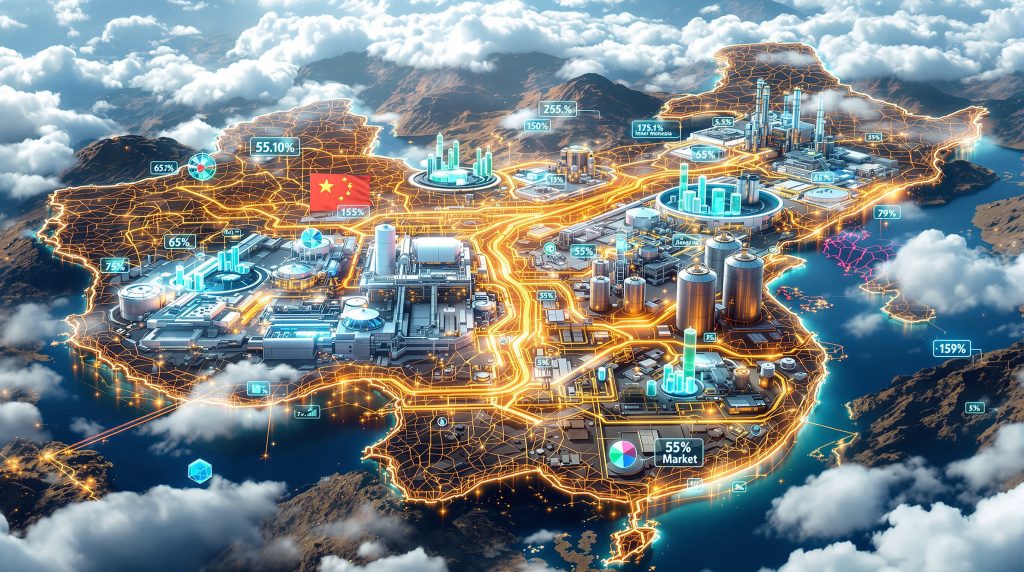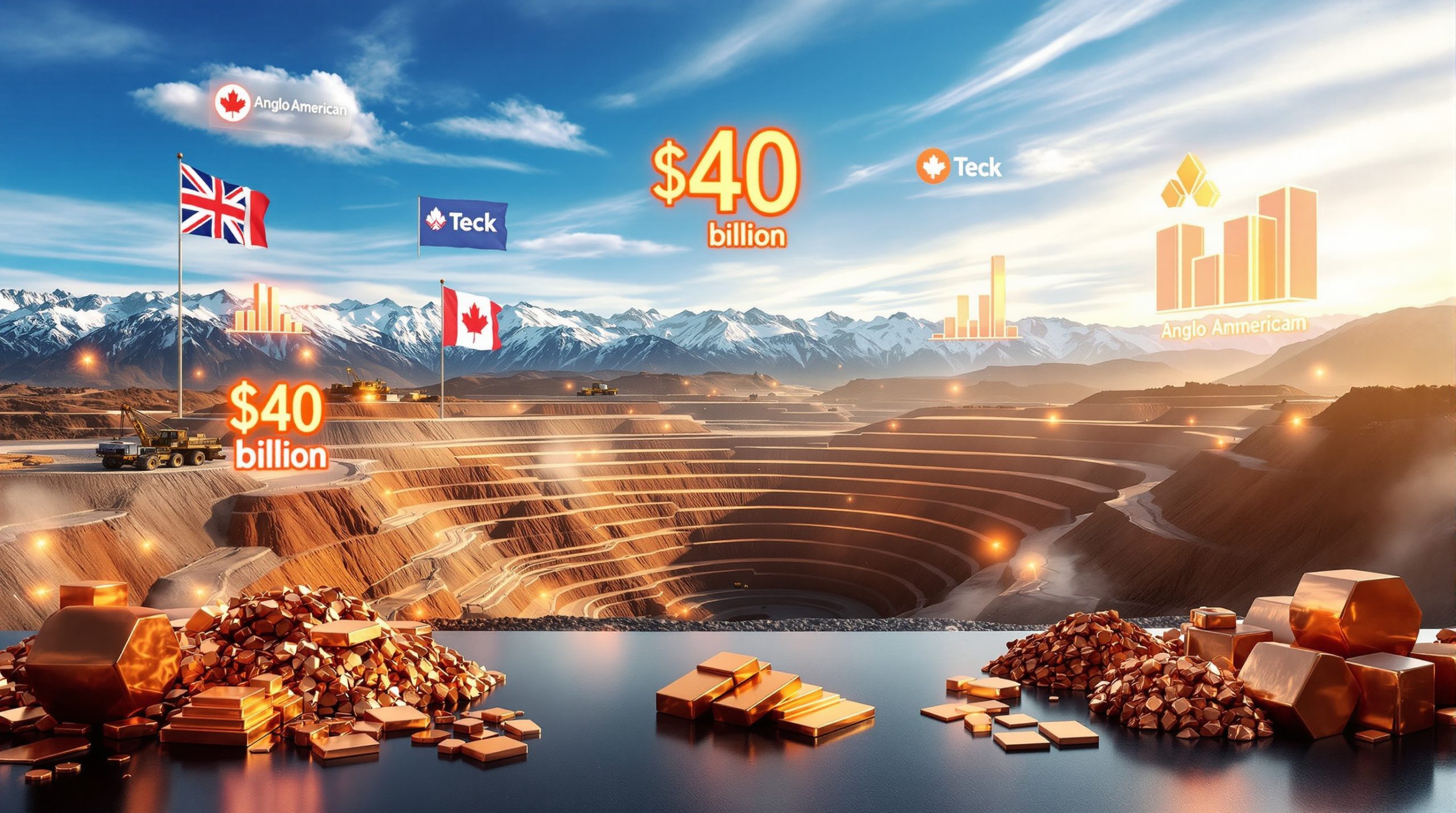China has systematically constructed an unprecedented industrial architecture that extends far beyond simple resource extraction. Through decades of coordinated investment and strategic planning, the nation has developed China's two rare earth bases that collectively control the global supply of critical raw materials essential for modern technology. These integrated hubs represent a sophisticated approach to industrial dominance that combines mining operations, advanced processing capabilities, and cutting-edge manufacturing within carefully orchestrated geographic zones.
The scale of this achievement becomes apparent when examining the numbers: China commands approximately 92% of global refined rare earth production and manufactures an estimated 87-90% of the world's permanent magnets. This concentration of capability within two primary industrial complexes creates an integrated ecosystem that stretches from raw material extraction through the most sophisticated technological applications.
China's Dual Rare Earth Base System
| Industrial Hub | Geographic Focus | Primary Elements | Strategic Function |
|---|---|---|---|
| Northern Complex (Baotou Region) | Inner Mongolia | Light rare earths (neodymium, praseodymium) | Mining extraction & basic processing |
| Southern Complex (Ganzhou Region) | Jiangxi Province | Heavy rare earths (dysprosium, terbium) | Advanced processing & R&D innovation |
Northern Industrial Hub: Light Rare Earth Powerhouse
The Baotou-centered northern complex operates as the foundation of China's light rare earth strategy, built around the Bayan Obo mine, which contains the planet's most significant concentrated rare earth deposit. This facility alone processes approximately 58% of China's national rare earth output, transforming raw ore into the materials that power everything from electric vehicle motors to wind turbine generators.
The geological advantages of this region cannot be overstated. The Bayan Obo deposit holds an estimated 83% of China's total rare earth reserves and produces over 100,000 tonnes annually of rare earth concentrates. This massive scale enables China to maintain cost advantages that make competing operations economically challenging for other nations.
Integrated Manufacturing Excellence
What distinguishes the northern base from traditional mining operations is its comprehensive integration of downstream manufacturing. The region houses sophisticated facilities that produce neodymium-iron-boron (NdFeB) magnets under controlled conditions that meet the exacting specifications required for aerospace, automotive, and defence applications.
Key Manufacturing Capabilities:
• Clean room environments maintained at ISO Class 6-7 standards for precision magnet production
• Automotive-grade magnet facilities capable of producing components for electric vehicle motors
• Quality control systems meeting AS9100 aerospace standards
• Metallurgical research laboratories developing next-generation alloy compositions
The proximity of mining, processing, and manufacturing operations creates rapid feedback loops that allow producers to adjust specifications and accelerate development cycles. Where traditional supply chains might require 8-12 weeks to implement composition changes, integrated facilities can modify alloy specifications within 2-4 weeks of customer requirements.
Technology Development Infrastructure
The northern base extends beyond production to encompass significant research and development capabilities. Partnerships with institutions like the Baotou Research Institute for Rare Earths enable continuous innovation in processing techniques and application development. This integration of academic research with industrial production creates a dynamic environment for technological advancement.
Southern Complex: Heavy Rare Earth Specialisation
The Ganzhou-centered southern industrial zone represents perhaps the most strategically significant component of China's rare earth architecture. This region specialises in heavy rare earth elements extracted from ion-adsorption clay deposits, processing materials that have no viable alternative sources outside of China.
The southern base controls an estimated 99% of global heavy rare earth refining capacity, giving China near-total command over elements essential for the most advanced technological applications. These materials include dysprosium for high-temperature permanent magnets, terbium for advanced phosphors, and yttrium for laser systems and medical imaging equipment.
Critical Element Production
Heavy Rare Earth Applications and Global Demand:
• Dysprosium: 600-800 tonnes annual global demand, primarily for wind turbine generators and defence applications
• Terbium: 100-150 tonnes annually, essential for LED phosphors and display technologies
• Yttrium: 5,000-7,000 tonnes yearly consumption, critical for medical imaging and laser systems
• Europium: 50-70 tonnes annual demand, vital for red phosphors in displays and lighting
Advanced Processing Technology
The southern complex employs sophisticated ion-exchange separation processes that achieve 99.9% purity levels for individual rare earth elements. This technological capability represents decades of development in hydrometallurgical processes, utilising multi-stage separation cascades and organic extractants that enable precise isolation of specific lanthanides.
The complexity of these operations extends to managing radioactive thorium byproducts, which constitute 0.1-0.5% of processed ore by weight. Specialised containment and storage facilities handle this challenge, representing significant environmental and regulatory expertise that creates additional barriers for potential competitors.
Vertical Integration Advantages
The strategic positioning of China's two rare earth bases creates unprecedented vertical integration advantages that extend far beyond simple cost savings. This coordination eliminates traditional supply chain vulnerabilities whilst accelerating innovation cycles and improving quality control across the entire production spectrum.
Supply Chain Integration Benefits:
• Transportation distances reduced from 1,000+ km to less than 50 km between extraction and processing
• Processing lead times accelerated by 30-40% compared to geographically dispersed operations
• Quality specification modifications implemented within 48-72 hours of customer feedback
• Environmental monitoring systems coordinated across the entire value chain
This integration creates information advantages that favour Chinese manufacturers. Where Western companies must coordinate across multiple suppliers and jurisdictions, integrated producers can optimise parameters across the entire value chain whilst maintaining proprietary control over process innovations.
Manufacturing Infrastructure and Capabilities
Both industrial bases house manufacturing operations that extend well beyond basic materials processing. These facilities transform rare earth elements into finished products for global technology markets, capturing value-added segments that traditionally represented the most profitable aspects of the supply chain.
Furthermore, this vertical integration approach demonstrates how mining industry evolution continues to reshape global commodity markets.
Permanent Magnet Production
The combined facilities maintain annual production capacity exceeding 200,000 tonnes of permanent magnets, serving markets ranging from consumer electronics to industrial machinery. This scale enables economies of production that maintain cost advantages whilst supporting continuous capacity expansion.
Modern electric vehicles require 2-5 kg of permanent magnets per vehicle, whilst offshore wind turbines utilise approximately 600 kg of permanent magnets for 12 MW direct-drive generators. These applications demand precise magnetic property specifications and thermal stability requirements that integrated production facilities can meet consistently.
Advanced Materials Development
Beyond magnet production, the bases develop specialised materials for emerging applications:
• Rare earth catalysts for petroleum refining and chemical processing
• Phosphor materials for advanced lighting and display technologies
• Specialised alloys for nuclear reactor and aerospace applications
• Hydrogen storage materials supporting fuel cell technology development
State Coordination and Enterprise Integration
The success of China's two rare earth bases reflects sophisticated coordination between government policy, state-owned enterprises, and private sector capabilities. This alignment enables rapid scaling of production capacity and coordinated technology development that would be difficult to achieve through purely market-driven mechanisms.
Policy Integration Framework
Chinese authorities utilise multiple policy tools to support the dual-base strategy:
Regulatory Mechanisms:
• Export licensing systems that prioritise domestic value-added processing
• Environmental regulations that consolidate production in approved industrial zones
• Research funding directed toward breakthrough technologies and process improvements
• Infrastructure investments supporting industrial expansion and logistics optimisation
Enterprise Coordination Model
The operational structure combines different types of organisations to maximise efficiency and strategic control:
• State-owned enterprises manage large-scale mining operations and basic processing
• Private companies focus on specialised processing and advanced manufacturing applications
• Joint ventures facilitate technology transfer and capacity building initiatives
• Regional governments provide regulatory support and infrastructure development coordination
Global Market Impact and Strategic Leverage
The concentration of rare earth production within China's two rare earth bases creates significant influence over global technology supply chains. This positioning enables Beijing to affect pricing, availability, and technology development timelines across multiple industries simultaneously.
In addition, this strategic positioning directly impacts critical minerals and energy security considerations for nations worldwide.
Strategic Market Control Metrics:
• 92% of global refined rare earth production originates from Chinese facilities
• 99% of heavy rare earth processing capacity is concentrated within the southern base region
• Over 70% of rare earth-related patents are filed by Chinese entities associated with these industrial zones
• 87-90% of permanent magnet manufacturing occurs within these coordinated facilities
This concentration creates leverage that extends beyond simple supply control. By controlling processing capabilities, China influences the development of new technologies and applications, potentially determining which innovations reach commercial viability and at what pace.
Export Control Mechanisms and Geopolitical Applications
China leverages its production dominance through sophisticated export control systems that create additional layers of strategic influence. Recent policy developments demonstrate how concentrated production capabilities enable geopolitical leverage over critical technology sectors.
Regulatory Control Systems
Since 2023, Chinese authorities have implemented stricter export controls affecting rare earth materials and downstream products:
Current Control Mechanisms:
• Export licensing requirements for rare earth oxides and refined compounds
• End-user verification systems for defence-related applications and sensitive technologies
• Traceability requirements for heavy rare earth shipments to international customers
• Technology transfer requirements for foreign investors in domestic operations
Strategic Policy Applications
These controls enable selective influence over global supply chains without requiring complete export embargoes. By implementing delays, requiring additional documentation, or prioritising certain customers, Chinese authorities can affect international technology development and manufacturing schedules.
However, recent developments including a critical minerals executive order demonstrate growing Western recognition of these vulnerabilities.
Recent export control expansions demonstrate how production concentration enables strategic leverage over global technology sectors, creating dependencies that extend far beyond simple material supply relationships.
Western Vulnerabilities and Dependencies
The concentration of rare earth capabilities within China's two rare earth bases creates critical vulnerabilities for Western technology sectors, defence industries, and clean energy transitions. These dependencies span multiple strategic sectors and represent significant national security considerations.
Supply Chain Dependencies
Critical Western Dependencies:
• United States: Mountain Pass mine output requires Chinese processing facilities for separation and refining
• European Union: Rare earth projects remain years from commercial production at meaningful scales
• Australia: Lynas Corporation operations depend on Chinese-supplied heavy rare earth materials for complete product ranges
• Japan: Magnet manufacturers source approximately 90% of rare earth materials from Chinese suppliers
Defence Sector Vulnerabilities
Modern defence systems exhibit extensive rare earth dependencies that create strategic vulnerabilities:
Military Applications Requiring Chinese Rare Earths:
• F-35 fighter jets utilise Chinese-processed rare earths in avionics and sensor systems
• Naval radar systems depend on terbium and dysprosium from southern base facilities
• Missile guidance systems require europium and yttrium processed in Ganzhou region facilities
• Stealth aircraft coatings incorporate specialised rare earth compounds from integrated Chinese production
Consequently, these dependencies highlight critical issues within defence critical minerals supply chains.
Clean Energy Technology Dependencies
The global transition to renewable energy creates additional dependencies on Chinese rare earth capabilities:
• Wind turbine generators require dysprosium-doped permanent magnets produced almost exclusively in China
• Electric vehicle motors utilise neodymium-praseodymium magnets from northern base facilities
• Solar panel production incorporates rare earth phosphors processed in southern complex facilities
• Energy storage systems increasingly utilise rare earth components for power electronics and control systems
Western Response Strategies and Limitations
Recognition of rare earth vulnerabilities has prompted coordinated responses among Western allies, though implementation faces significant technical, economic, and timeline challenges that may limit effectiveness in addressing current dependencies.
Domestic Production Initiatives
Major Western Investment Programmes:
• United States: $3.16 billion allocated for critical mineral processing facilities under the Defence Production Act
• Canada: Development of separation capabilities for Quebec rare earth deposits through government-industry partnerships
• Australia: Lynas Corporation capacity expansion for heavy rare earth processing outside China
• European Union: Strategic autonomy targets calling for 10% domestic production by 2030
Alternative Supply Chain Development
Western nations are pursuing multiple strategies to reduce dependence on Chinese rare earth processing:
Diversification Initiatives:
• Partnerships with African rare earth projects in Burundi, Tanzania, and Madagascar
• Investment in recycling technologies for permanent magnet recovery from electronic waste
• Research into rare earth-free alternatives for specific applications and technologies
• Strategic stockpiling programmes for critical defence and infrastructure applications
Implementation Challenges
Despite significant investment commitments, Western efforts face substantial obstacles:
• Technical barriers: Rare earth separation requires specialised expertise developed over decades
• Environmental considerations: Processing operations generate significant waste streams and regulatory challenges
• Economic competitiveness: Chinese integrated production maintains 30-40% cost advantages over potential Western alternatives
• Timeline constraints: New facilities require 5-10 years from planning to commercial production
Long-Term Strategic Implications
China's two rare earth bases represent a coordinated national strategy that positions the country to maintain technological leadership in critical industries for the foreseeable future. This approach extends beyond resource control to encompass innovation leadership and market development.
Technology Development Leadership
The integration of research, development, and production within the dual-base system creates advantages for technological innovation:
Innovation Capabilities:
• Artificial intelligence integration in processing optimisation and quality control systems
• Development of next-generation permanent magnet compositions with improved performance characteristics
• Advanced recycling technologies for circular economy applications and resource efficiency
• Breakthrough rare earth applications in quantum computing and advanced renewable energy systems
Global Economic Restructuring
The dual-base system enables China to influence fundamental aspects of global technology development:
• Technology development timelines: Control over critical materials affects which innovations reach commercial viability
• Value-added manufacturing: Capture of higher-margin segments previously dominated by Western companies
• International standards: Influence over technical specifications and performance requirements for rare earth-dependent technologies
• Geopolitical leverage: Resource access becomes a tool for broader diplomatic and strategic objectives
Future Industry Implications
As technological applications for rare earth elements continue expanding, Chinese advantages may compound:
Emerging Applications:
• Quantum computing systems requiring ultra-pure rare earth compounds
• Advanced energy storage technologies incorporating rare earth electrochemical materials
• Next-generation telecommunications infrastructure utilising rare earth-based components
• Space technology applications demanding specialised rare earth alloys and compounds
Market Psychology and Investment Considerations
The concentration of rare earth capabilities within China's two rare earth bases creates unique market dynamics that affect investment strategies and long-term planning across multiple sectors.
Supply Security Premiums
Companies dependent on rare earth materials increasingly factor supply security considerations into strategic planning and investment decisions. This trend creates premium valuations for operations with diversified supply chains or domestic processing capabilities.
Strategic Stockpiling Trends
Both government and private sector entities are implementing stockpiling strategies to mitigate supply disruption risks:
• Defence contractors maintain 90-180 day inventory levels for critical rare earth components
• Technology companies establish strategic reserves for key production inputs
• National governments create emergency stockpiles for economic and security contingencies
Alternative Technology Investment
Recognition of supply chain vulnerabilities drives investment in alternative technologies and materials:
• Research into rare earth-free motor designs for electric vehicles and industrial applications
• Development of substitute materials for display and lighting technologies
• Innovation in recycling and recovery technologies for rare earth element reuse
Technical Specifications and Quality Considerations
The sophisticated processing capabilities within China's two rare earth bases enable production of materials meeting the most demanding technical specifications across multiple industries.
Magnetic Property Standards
Permanent magnet applications require precise magnetic property specifications:
Critical Performance Metrics:
• Magnetic flux density: Measured in Tesla, determining motor efficiency and power output
• Coercivity: Measured in kA/m, affecting temperature stability and demagnetisation resistance
• Energy product: Measured in kJ/m³, determining overall magnet performance and efficiency
• Thermal stability: Operating temperature ranges from 150°C for automotive applications to 200°C for industrial systems
Purity Requirements
Advanced applications demand exceptional material purity levels:
• Electronics applications: 99.99% minimum purity for semiconductor and display technologies
• Aerospace specifications: 99.9% purity with controlled impurity profiles for specialised alloys
• Medical imaging: Ultra-high purity requirements for contrast agents and imaging equipment
• Defence systems: Military specifications requiring traceable purity and composition verification
Environmental and Regulatory Factors
The operation of China's two rare earth bases involves sophisticated environmental management systems that address the complex challenges associated with rare earth processing operations.
Environmental Management Systems
Integrated Environmental Approaches:
• Water consumption optimisation across mining-to-manufacturing value chains (20-30 cubic metres per tonne of rare earth oxide produced)
• Waste stream coordination and processing efficiency improvements
• Air emissions monitoring and control systems meeting national environmental standards
• Radioactive thorium byproduct management and long-term storage solutions
Regulatory Compliance Framework
Chinese authorities implement coordinated regulatory oversight across both bases:
• Environmental impact assessments for all new facilities and capacity expansions
• Workplace safety standards meeting international occupational health requirements
• Quality management systems ensuring consistent product specifications and traceability
• Export compliance verification for international shipments and technology transfer activities
Frequently Asked Questions About China's Rare Earth Bases
Can other countries successfully replicate China's two-base model?
Whilst technically feasible, replicating China's integrated approach would require decades of sustained investment, acceptance of environmental challenges, and coordinated industrial policy that most Western nations find politically and economically challenging to implement consistently.
How resilient are these bases to potential disruptions?
Both bases benefit from geographic separation, redundant infrastructure, and strategic material reserves that provide significant resilience against natural disasters, technical failures, or geopolitical tensions. The dual-base structure itself creates redundancy and operational flexibility.
What environmental standards apply to these industrial operations?
China has implemented increasingly strict environmental regulations within these bases, including water usage limitations, waste stream management requirements, and air quality standards. Critics note that environmental consolidation serves strategic industrial objectives alongside environmental protection goals.
How do quality standards compare to international specifications?
Processing facilities within both bases maintain quality management systems meeting international standards including ISO 9001, AS9100 for aerospace applications, and industry-specific requirements for automotive, electronics, and defence sectors.
What timeline would be required for Western alternatives to achieve meaningful scale?
Industry analysts estimate that establishing comparable processing capabilities would require 5-10 years for individual facilities and 15-20 years for integrated industrial complexes approaching the scale and sophistication of China's two-base system.
Furthermore, China's dominance in rare earth processing continues to present significant challenges for alternative supply chain development.
Strategic Insight: China's dual rare earth base system represents more than industrial infrastructure; it constitutes a coordinated national strategy designed to maintain technological leadership in critical industries through integrated control of essential material supply chains, processing capabilities, and innovation development for decades to come.
Ready to capitalise on the next strategic mineral discovery?
Discovery Alert's proprietary Discovery IQ model delivers real-time notifications on significant ASX mineral discoveries, instantly empowering investors to identify actionable opportunities ahead of the broader market. Understand why historic discoveries can generate substantial returns by exploring proven examples of exceptional market outcomes and begin your 30-day free trial today to position yourself strategically in this evolving landscape.




